15 Types of Crane Bird Species in 2024 (With Pictures)
Last Updated on
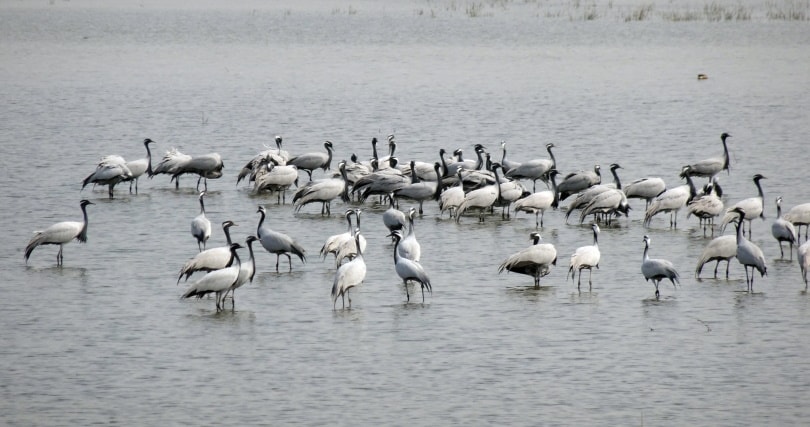
There’s no doubt that cranes are one of the most impressive bird species on the planet. They have massive bodies and long legs, creating a spectacle to behold. Once you add in their colorful plumage, no other bird can compare.
But as of 2021, there are only 15 crane species left, and the IUCN has listed a few of them as endangered. So, what crane species are currently out there?

The 15 Types of Crane Bird Species
1. Black-Crowned Crane

You can find black-crowned cranes in Africa’s sub-Saharan regions, but you can also find them in grasslands and croplands of the savannah. They’re about 3 feet tall and weigh about 8 pounds and eat whatever they can get their hands on, primarily insects and small reptiles.
Currently, the IUCN has listed the black-crowned crane as vulnerable, and there are only 28,000 to 47,000 of the birds remaining.
2. Grey-Crowned Crane

Grey-crowned cranes are similar in size and weight, and they also live in southern and eastern Africa. But while black-crowned cranes have primarily black plumage, the grey-crowned crane’s plumage is aptly grey.
Moreover, while the black-crowned crane primarily eats insects and reptiles, the grey-crowned crane is an omnivore that will eat plants, eggs, snakes, insects, and small reptiles.
Currently, the grey-crowned crane is listed as endangered, and between 58,000 and 77,000 of them remain in the wild.
3. Demoiselle Crane
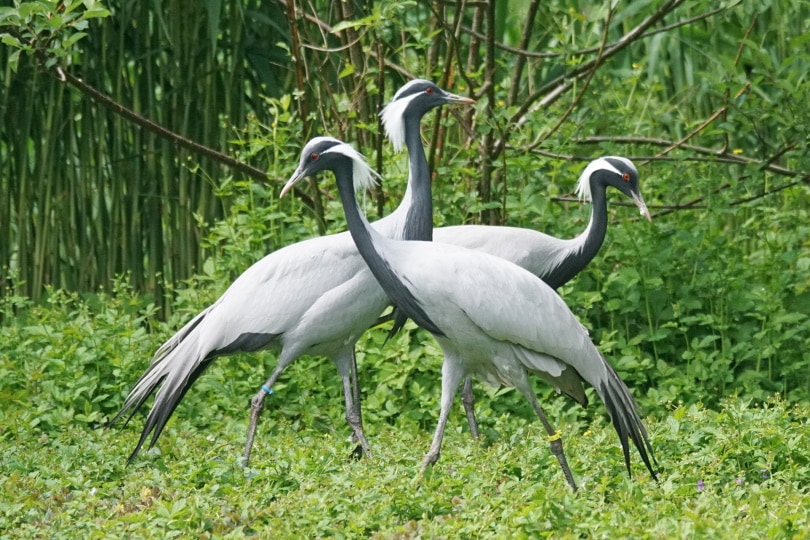
Demoiselle cranes are similar in size to both the black- and grey-crowned cranes, but they’re actually even lighter, only weighing in at 6 pounds apiece. They also live way farther north, inhabiting Eurasia from the Black Sea all the way to China.
Demoiselle cranes are still thriving, with anywhere between 230,000 and 260,000 in the wild.
4. Blue Crane
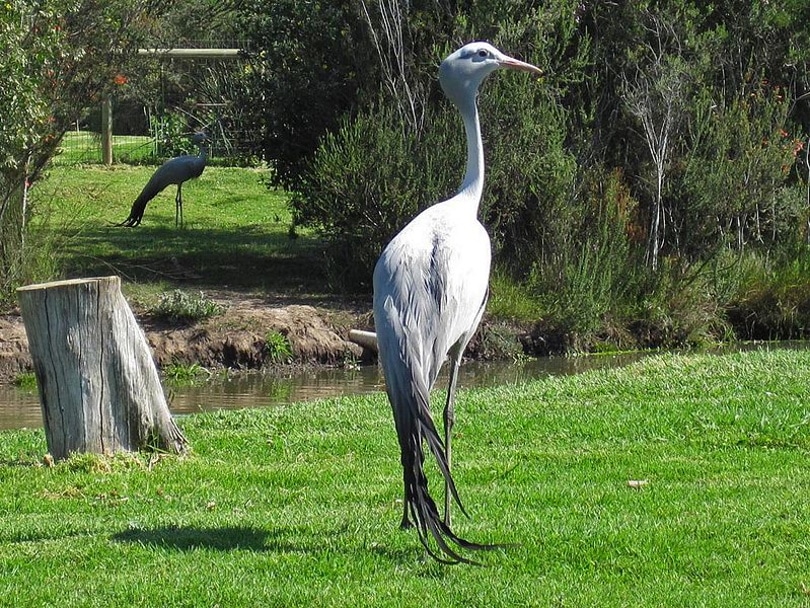
If you’re looking for a blue crane, you’ll have to travel to South Africa, where they’re the country’s national bird. Not only do they inhabit the smallest range of all the crane species, but they’re also listed as vulnerable, with only about 26,000 birds left.
These impressive birds are about 4 feet tall and weigh in at 11 pounds. While there’s no doubt that many of these birds have a slightly blue hue to their plumage, many are simply white, and despite their name, they never have an extremely bright blue appearance.
5. Wattled Crane
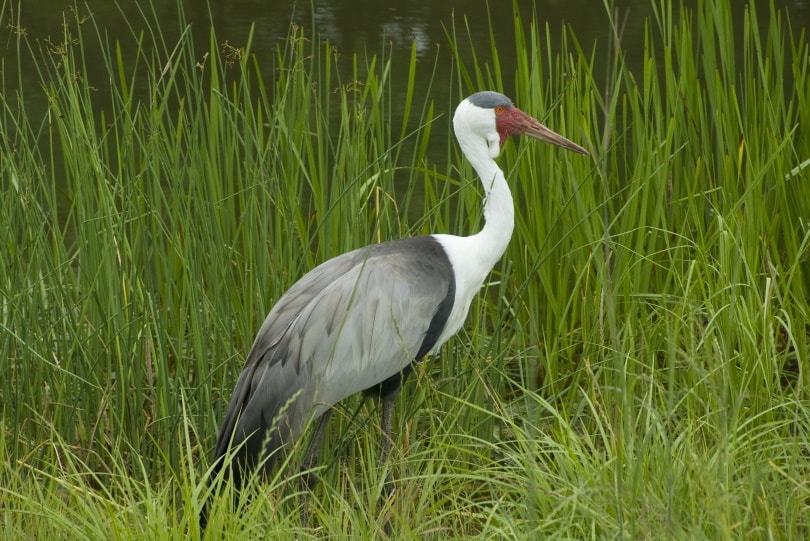
Wattled cranes are definitely on the larger size of the species and among the more impressive to look at. They stand at 6 feet tall and weigh 14 pounds. But if you’re looking to spot a wild wattled crane, you’ll have to travel south of the Saharan desert.
In fact, only about 7,000 of these cranes are still in the wild, which means that you might not be able to keep spotting these impressive birds for much longer.
6. Siberian Crane
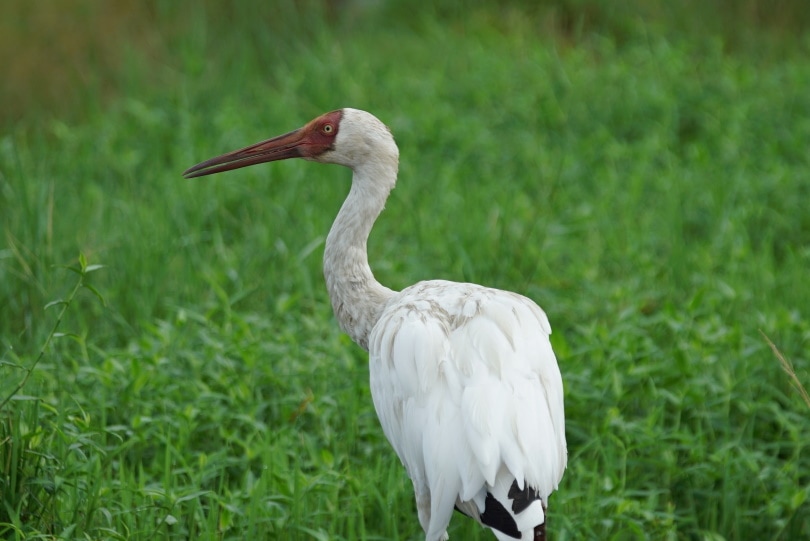
If you’re looking for Siberian cranes, head north — way north. These birds live in Russia’s arctic tundra, although you can spot them as far south as China and India during migration.
These birds are 5 feet tall and weigh 13 pounds. Additionally, they sport an all-white plumage, except for a few black feathers that you can only see while they’re flying.
The IUCN has listed these birds as critically endangered, so they’re only one step away from becoming extinct in the wild. Currently, there are 3,200 Siberian cranes in the wild, but about 98% of them migrate to a lake in Poyang, China, which is where China is building the Three Gorges Dam that is going to alter their breeding sites significantly.
There’s a good chance that these birds will become extinct in the wild before long.
7. Sandhill Crane
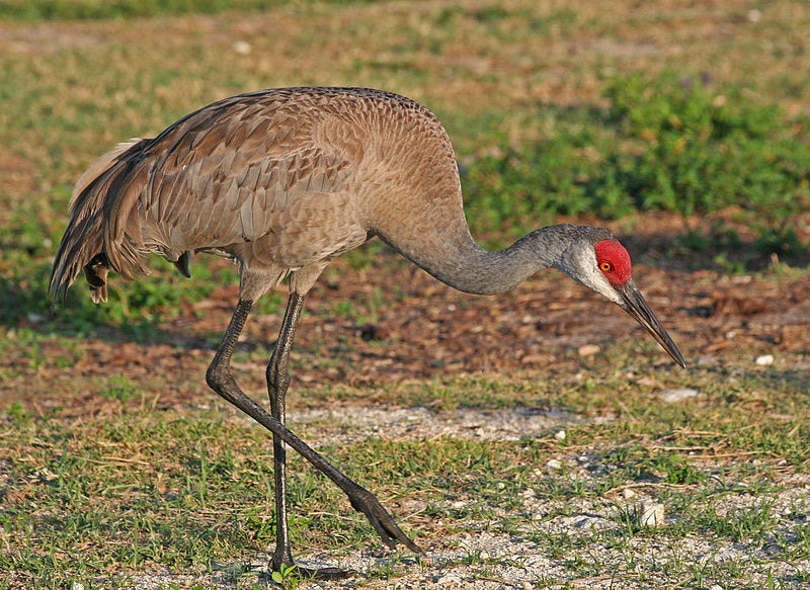
If you’re trying to spot a crane in North America, there might be no better target than the Sandhill crane. You can find Sandhill cranes as far south as Nebraska and all the way up to northeastern Siberia.
The IUCH has not listed sandhill cranes as an endangered or threatened species — in fact, there are more sandhill cranes in the world than any other crane species. Currently, there are about 650,000 sandhill cranes, but only about 100,000 of them are of the large crane variety.
8. Sarus Crane
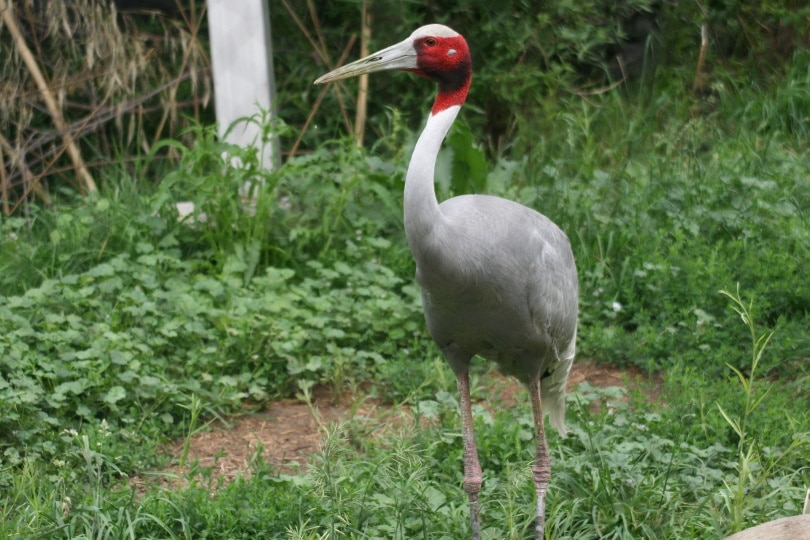
The sarus crane might not be the largest crane species in the world, but it’s close. They stand at 6 feet tall and weigh in at 14 pounds. If you’re trying to spot these cranes, you’ll need to head to southeastern Asia or Australia.
Currently, the sarus crane is listed as vulnerable, with 15,000 to 20,000 of them remaining in the wild.
- You might also like: The 20 Best Birding Blogs That You Should Follow
9. Brolga

Brolga cranes, also known as the Australian cranes, live in both Australia and New Guinea. If you’re looking for the largest cranes in the world, these are it. While they might not be the tallest cranes out there, they are the heaviest at 18 pounds. However, their 5-foot height isn’t too shabby either.
The IUCN has listed Brolga cranes as a species of “least concern” — their population is decreasing, but it’s doing so at an extremely low rate. Currently, there are about 10,000 of these cranes living in the wild.
10. White-Naped Crane
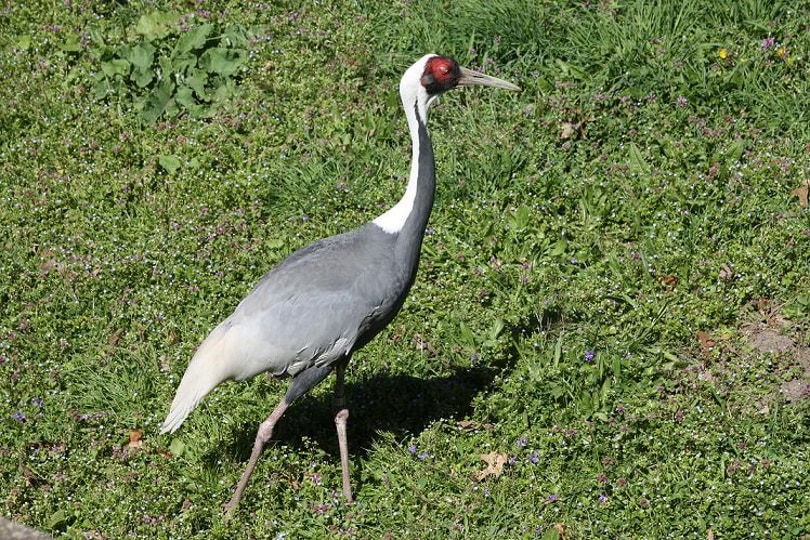
White-naped cranes stand about 4 feet tall, which is on the shorter end of the crane family. Still, they weigh in on the heavier side at 12 pounds.
You can find these birds in eastern Asia, as far west as China and Russia and as far east as Taiwan and Japan. The IUCN has listed white-naped cranes as vulnerable, and currently, only about 5,000 of them remain in the wild.
11. Hooded Crane
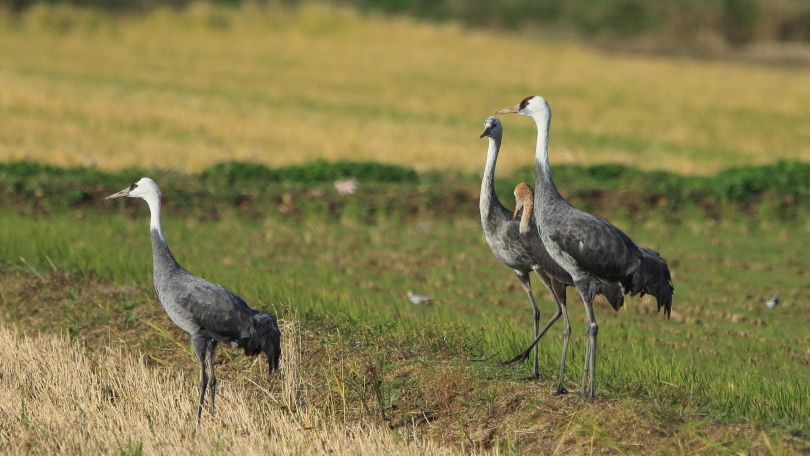
Hooded cranes get their name due to a patch of bare red skin right above their eyes, making them look like they’re wearing a hood. They stand just over 3 feet tall and weigh in at 8 pounds, making them a smaller member of the crane family.
You can find these birds in Eastern Russia, China, and Japan, but they face threats created by dam building, and the IUCN has currently listed them as vulnerable. Now, about 11,000 hooded cranes still live in the wild.
12. Eurasian Crane

Eurasian cranes, also known as common cranes, are among the easiest cranes to spot if you live in Asia or Europe. They live in Norway and Russia, but you can find them wintering as far south as central Africa.
Since they migrate over everywhere in between, they have one of the largest ranges of any of the crane species. These cranes stand at 4 feet tall and weigh about 10 pounds, making them smaller members of the crane family.
Currently, the IUCN has listed these birds in the “least concern” category, and there are about 600,000 of them in the wild.
13. Whooping Crane

Perhaps the most well-known crane is the whooping crane. They live in North America but only have small grounds in northern Canada and Wisconsin. They winter as far south as Florida and Mexico, though, so you can spot a whooping crane anywhere in between when they’re migrating.
The whooping crane is currently listed as endangered, with only about 800 birds left in the wild. This makes the whooping crane one of the rarest birds to spot in the wild. These cranes are among the largest in the crane family, standing 5 feet tall and weighing 16 pounds.
14. Black-Necked Crane

A small crane is the black-necked crane. They stand 4 feet tall and weigh 12 pounds, which still makes them an impressive bird. All the black-necked cranes live in a single population, and they thrive in wetlands.
You can find these birds in Northern India and Bhutan, and they are currently classified as near threatened. There are close to 9,000 or 10,000 black-necked cranes left in the wild.
15. Red-Crowned Crane
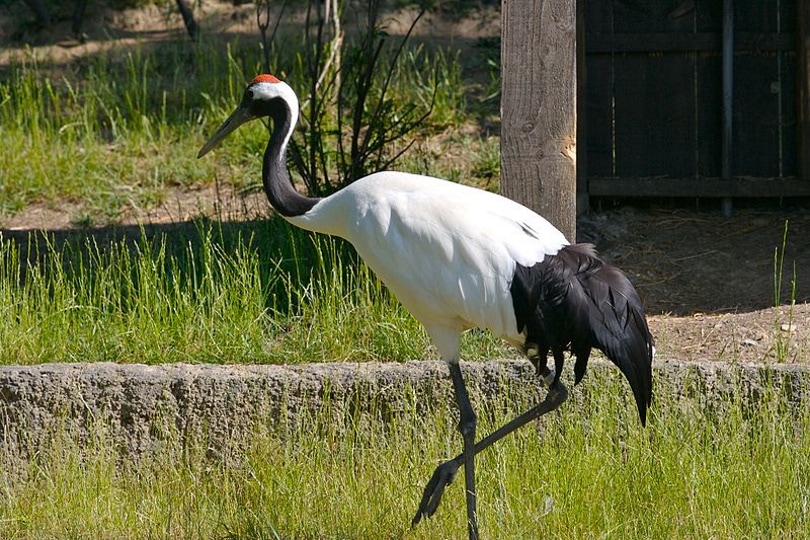
A massive crane species is the red-crowned crane. They are 5 feet tall and nearly miss the largest crane title by weighing in at 17 pounds. If you’re looking to spot this bird, you’ll have to travel to Eastern China, Korea, or Japan.
But even then, it’s hard to spot these beautiful birds with only 1,800 of them left in the wild.

Summary
If you’re looking for a big and beautiful bird, it’s hard to beat the crane. Standing between 4-6 feet tall, they’re a spectacle to behold.
Unfortunately, their populations are dwindling, and it’s unlikely that the 15 types of crane species will be left in the wild for long. They love wetlands, and wetlands are shrinking, but while they’re still out there, cranes are worth cherishing.
Check out some of our other top trending birding posts:
- 10 Types of Birds of Prey (with Pictures)
- 8 Types of Bird Houses: Which Is Right for You?
- 15 Species of Hawks in Arizona
Featured Image Credit: Piqsels
Table of Contents
About the Author Robert Sparks
Robert’s obsession with all things optical started early in life, when his optician father would bring home prototypes for Robert to play with. Nowadays, Robert is dedicated to helping others find the right optics for their needs. His hobbies include astronomy, astrophysics, and model building. Originally from Newark, NJ, he resides in Santa Fe, New Mexico, where the nighttime skies are filled with glittering stars.
Related Articles:
Monocular vs Telescope: Differences Explained (With Pictures)
How to Clean a Refractor Telescope: Step-by-Step Guide
How to Clean a Telescope Eyepiece: Step-by-Step Guide
How to Clean a Rifle Scope: 8 Expert Tips
What Is a Monocular Used For? 8 Common Functions
How to Clean a Telescope Mirror: 8 Expert Tips
Brightfield vs Phase Contrast Microscopy: The Differences Explained
SkyCamHD Drone Review: Pros, Cons, FAQ, & Verdict
